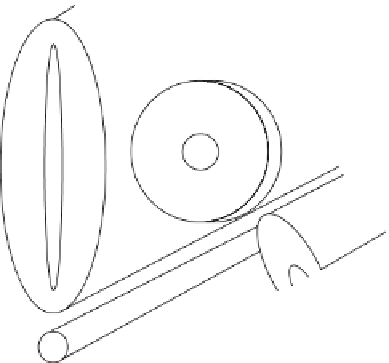Biology Reference
In-Depth Information
DE
NT
Sm
LM
Wnt1
Shh
Wnt7a
Bmp4
Noggin
Nc
Figure 3.27
A simplified scheme of signaling molecules in newly formed epithelial somite.
Shh (ochre dots), produced by notochord (Nc) and floor plate, acts on the ventral domain
of newly formed epithelial somites, inducing sclerotome, and also on the dorso-medial
domain, inducing medial dermomyotome. Wnt1 (red dots), produced by dorsal neural tube
(NT), acts (with Shh) on the dorso-medial domain of newly formed somites (Sm), where
Myf5
expression is observed soon after and epaxial progenitors are specified. Wnt7a (blue
dots), produced by dorsal ectoderm (DE), acts on the dorso-lateral domain, where hypaxial
progenitors are specified. BMP4 (brown polygons), produced by lateral mesoderm (LM),
prevents
MyoD
activation and early differentiation in the lateral domain of somites. Its action
is counteracted by direct binding of Noggin (green triangles) produced by dorsal neural tube.
Source
: From Cossu and Borello (1999).
(
Unguez and Zakon, 2002
). In juvenile
Xenopus
frogs, the laryngeal muscle,
muscu-
lus dilator laryngis
, is monomorphic (i.e., identical in both sexes). After metamor-
phosis, the muscle becomes sexually dimorphic. The male muscle grows six to seven
times larger than that of the female. The difference is explained by the high levels
of circulating androgen in males at puberty (
Sassoon and Kelley, 1986
). Although
it is well known that puberty and the associating rise of androgen levels in males
is determined and regulated by neural mechanisms, further studies show that the
nervous system induces the “masculinization” of the muscle, not only via the long-
range neurohormonal pathway, but also directly via muscle innervation. The mani-
fold increase in muscle fibers in males depends on both the circulating androgen and
muscle innervation. The latter also affects the fiber growth. Denervation of the mus-
cle causes its atrophy (
Tobias et al., 1993
).
In chick embryos, motor neurons, upon entering the limb Anlagen, release the
retinoic acid-synthesizing enzyme (RALDH-2), inducing muscle cell differen-
tiation and muscle formation. Recently, evidence has been presented that in chick





















































































Search WWH ::

Custom Search